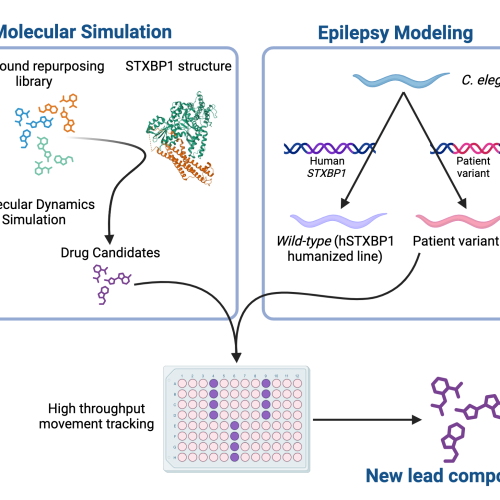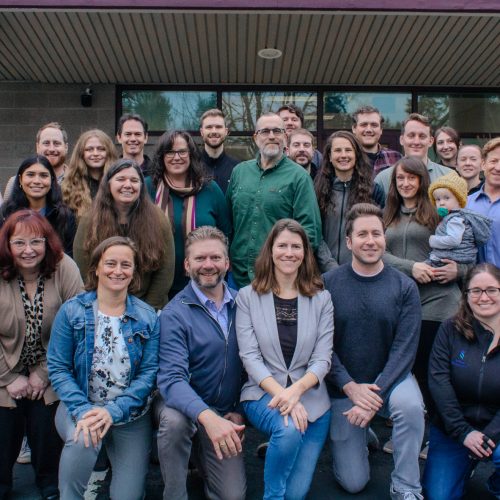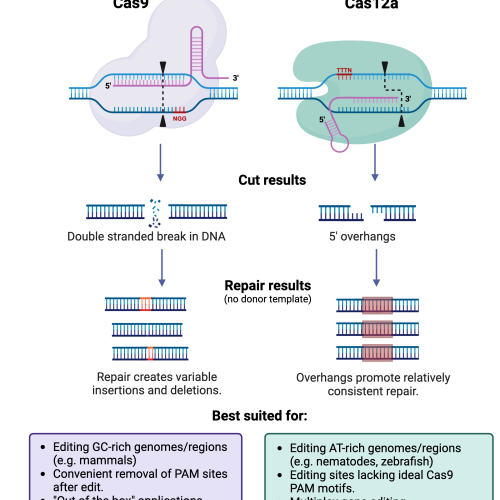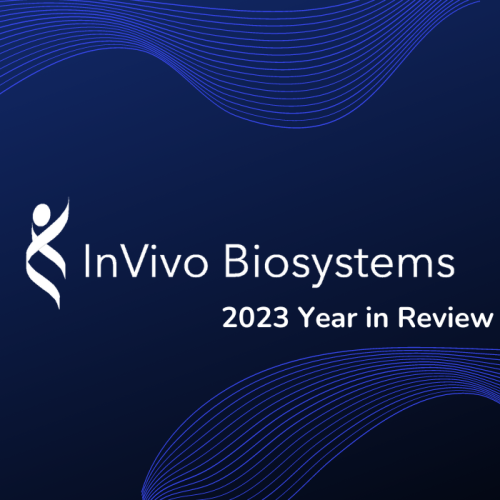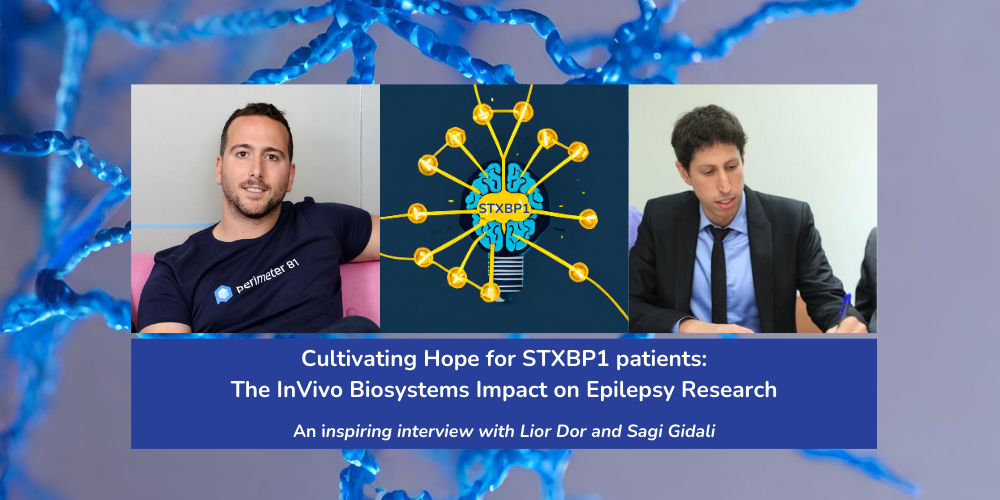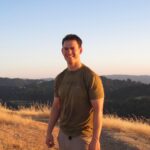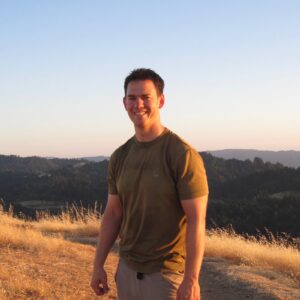In this epilepsy news customer story on STXBP1 epilepsy, we have the pleasure of hearing from Lior Dor and Sagi Gidali from the Rare Smile Foundation and Rafa’s Moonshots.
In a nutshell, STXBP1 epilepsy is a rare genetic disorder caused by mutations in the STXBP1 gene. This condition typically manifests with epilepsy as a primary symptom, often starting in infancy or early childhood. Individuals with STXBP1 epilepsy may experience various types of seizures, developmental delays, intellectual disabilities, movement disorders, and other neurological challenges. The severity and specific symptoms can vary widely among affected individuals. Treatment typically focuses on managing symptoms and may include antiepileptic medications and supportive therapies tailored to the individual’s needs.
Key Points:
- The Importance of Community and Collaboration in the Fight Against Rare Diseases: Both Lior and Sagi underscore the critical role that community and collaboration play in tackling rare diseases like STXBP1 disorder. Lior’s creation of the Rare Smile Foundation and Sagi’s establishment of Raphael’s Moonshots highlight their efforts to advance research and treatment options. The support system within the STXBP1 community, including sharing knowledge, experiences, and resources, is a cornerstone of their strategy to find effective treatments.
- Personal Journeys to Scientific Advocacy: Lior and Sagi each share their personal journey from the moment of their child’s diagnosis to becoming active advocates and contributors to scientific research. Lior leveraged his background in biology to understand and push for research advancements, while Sagi, despite initially having no background in biology, utilized his entrepreneurial expertise to expedite research efforts. Their transitions from personal crisis to scientific advocacy underscore the potential for individuals to make a meaningful impact in the search for cures for rare diseases, highlighting the impact of epilepsy on their everyday lives.
- Innovative Approaches to Finding Treatments: The discussion highlights innovative and proactive approaches to research for children with epilepsy, including the development of disease models (iPSC lines, zebrafish models, C. elegans models), drug repurposing, and exploring gene therapy. Their strategic use of both existing and cutting-edge scientific methods to expedite the search for effective treatments demonstrates a comprehensive and forward-thinking approach to overcoming the challenges posed by STXBP1-Related Disorders.
- The Role of Resilience and Hope: Throughout the interview process, a theme of resilience and hope emerges. Despite the initial despair following their children’s diagnoses, both Lior and Sagi transformed their experiences into action, focusing on the possibility of finding epilepsy treatments. Their stories are testaments to the strength of parents facing rare diseases and the impact of their efforts on the broader community and research landscape.
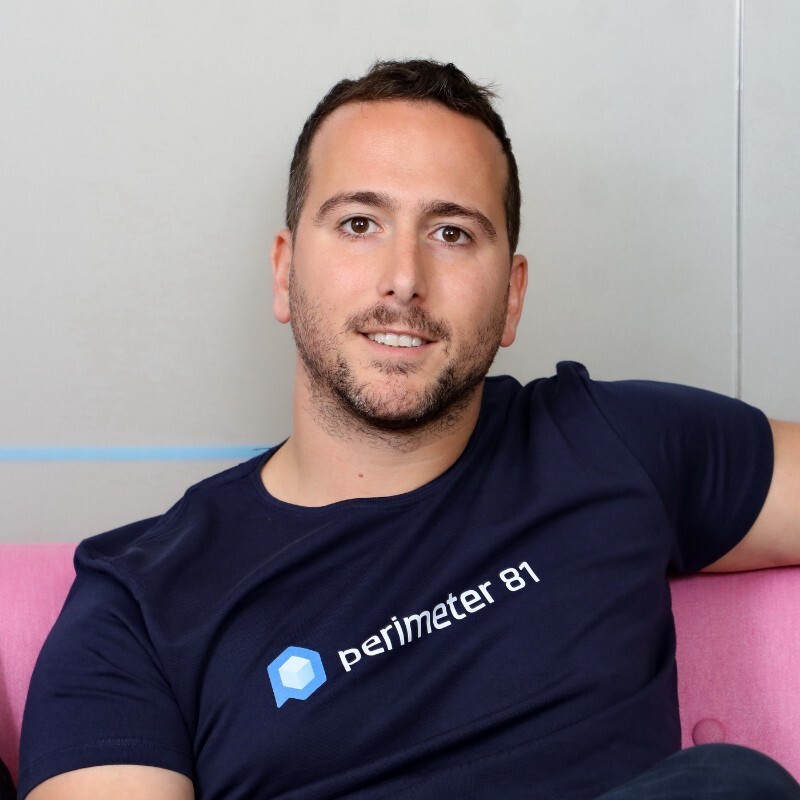
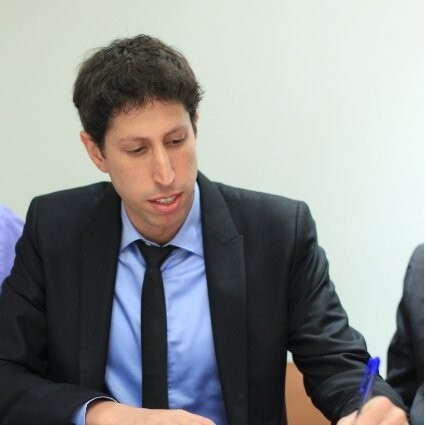

Introduction: Setting the Stage for an Inspiring Narrative
We recently had the privilege of speaking with two of our partners who are remarkably dedicated fathers, Lior Dor and Sagi Gidali. Both Lior and Sagi are experienced parents who’ve been on a unique journey, navigating the challenges associated with STXBP1 disorder. Lior and his wife Anat have a son Ran who was diagnosed with STXBP1 disorder in 2013, while Sagi and his wife Ella Gidali have a son Raphael who was diagnosed with STXBP1 disorder almost a year ago. Rather than accepting the response they received from doctors saying there was no viable treatment or cure, both Lior and Sagi along with their families rose up and took action themselves. Lior and Anat founded the Rare Smile Foundation, an extension of the STXBP1 foundation in Israel, leveraging Lior’s scientific expertise for making advancements. Sagi, despite his specialization in technology rather than biology or chemistry, utilized his entrepreneurial expertise alongside his wife Ella to open a new research fund for STXBP1 called “Rafa’s Moonshot”. Both the Rare Smile Foundation and Rafa’s Moonshot are now large contributors for accelerating STXBP1 research worldwide.
In our previous post Alternative Animal Models Unlock Hope in STXBP1 Epilepsy Research, we described the results of a collaboration between InVivo Biosystems and the Rare Smile Foundation. In Sagi and Ella’s journey, their collaboration between InVivo Biosystems, QR Genetics, an Israeli startup, and clinicians from Israel has resulted in an effective small molecule treatment for their son Raphael. The time from small molecule testing to treatment for Raphael was only 8 months, with the rapid discovery fueled by the InVivo Biosystems transgenic model platform.
Here, in their own words, Lior and Sagi describe the seeds they have sown for research where therapies are urgently needed while cultivating a support network for the rare disease community.
Watch the video interview or read the transcript (edited for brevity) below.
Full Interview Video:
Full Interview Transcript:
InVivo Biosystems
Hello and welcome everyone to the In Vivo Biosystems science blog. My name is Adam Saunders and I’m a senior scientist with In Vivo Biosystems. Today we have the privilege of speaking with two remarkable individuals, Lior Dor and Sagi Gidali. Both Lior and Sagi are experienced parents who’ve been on an extraordinary journey navigating the challenges associated with a rare disease known as STXBP1 disorder.
Lior, a researcher at ALYN Hospital and founder of the Rare Smile Foundation, brings a wealth of knowledge and experience to the field. And Sagi, an entrepreneur and philanthropist, has been actively supporting various research initiatives focused on STXBP1 disorder. Lior and Sagi, welcome.
Before we dive in, would you tell us a little more about your background and your current role in the STXBP1 community?
Lior Dor
As you mentioned, I came from a science background from biology. I was in graduate school when my STXBP1 child was born and since then I’m working, as you mentioned, in ALYN hospital as a research associate as well. And what I’m doing in this STXBP1 community, we, me and my wife, we generated Rare Smile, the Israel STXBP1 organization.
Currently we’re having several projects and the main goal is to advance research toward successful treatment for the children. That is the main goal that we’re trying to achieve.
Sagi Gidali
My name is Sagi Gidali. I’m Raphael’s dad, which was acknowledged in STXBP1 eleven months ago. In my career, I’m a cybersecurity entrepreneur. I sold two of my companies. The last one was acquired by Checkpoint, which is one of the largest cybersecurity companies in the world. That was three, four months ago.
And since then, me and my wife Ella–she’s a neurologist, by the way, so karma–we founded a research fund called Rafa’s Moonshots, which we’re going to launch in the next few weeks in this research plan. We’re aiming to find effective treatments to cure SDXBP1, and we can talk about it in this podcast and be happy to elaborate.
InVivo Biosystems
Thank you. Let’s start with that profound moment when you discovered that your child had a rare disease. What was that initial experience like and how have your reactions evolved over time?
Lior Dor
Well, Ran, our eldest son was born actually 4th of July, 2013. So he’s a little bit older than 10 now, 10 years.
And actually…it wasn’t initially diagnosed. It took about a year and several months, which was kind of fast in that time to get diagnosed. But it started when it was when he was 12 days old, he started seizing. And since then, everything changed.
We went to the hospital and everything began. And then we got the diagnosis, which told us that he’s having something that we didn’t know about. I mean, we just had the name of the gene and we got an article mentioned in several other cases in Japan surprisingly with the same variant, which is kind of a unique disorder.
I mean, there are disorders that most of the patients have the same variant, but in our disorder, STXBP1 epilepsy is far more unique. And since then we started to try to drill down to what we could do scientifically to help.
I mean, even though I was in my master’s in biology, I worked on fish genetics. So it’s kind of shocking. You have to understand what to do. And since then, we’ve been trying to gather information on what the disorder is, until we finally got to the notion that there weren’t enough resources out there and we need to be the ones to improve the situation. There was no other foundation at that time–we found a Facebook group, which was the one Facebook group that currently STXBP1 had, and there were less patients that time there.
And then we started our way. I mean, what I wanted to do is just advance research in order to try to improve my son’s condition. And from that we generated the foundation. It wasn’t the initial goal, actually. It just was because you cannot raise a fund if you’re a private guy, apparently, so we have to have kind of organization to try to do it. So this is how it began and since then we’re trying to push forward all the time to find a treatment or to advance treatment or research.
Sagi Gidali
For us, I remember like every single detail from the D Day, diagnosis day. Before that, we saw a global developmental delay, in Raphael. Well, as young parents, Raphael is our first boy son. So we really didn’t pay attention to many different details of flags that we had along the way, but eventually, the diagnosis was around one year.
When Raphael was one year and two months, we did many checks, metabolic blood tests, many others. And also, the exome sequencing is more popular today than it was before. So we did also that but we didn’t expect to get something in the result.
And apparently, we had a surgery for Raphael to improve hearing, because he had fluids in his ears, and then we went to pick up the results in the doctor’s office, and he had a stack of papers on the table, and I wondered why it’s flipped on the table and we cannot see what’s written.
And then he flipped the stack of papers and he said, we found something. I had zero knowledge in biology and that understanding back then and I’m catching up now. He started to explain the gene, STXBP1, pathogenic, epilepsy, global developmental delay, and many other symptoms that are related to the syndrome, and Ella just started to cry–she knew because she’s a neurologist, she had a background and she knew what’s going on and we were devastated for a week or two. And then we said that we need to do something. The doctor said there was no cure. And then we said, “There is something that we can do, we need to change that reality,” and that’s eventually what happened.
So we looked for information. The first name that we got was Lior and Anat, that founded the Rare Smile Foundation. Then we picked up the phone and we talked with them and and since then Lior and Anat gave us lots of support and the background to start with, and it turned into partnering together and working on different scientific projects to find treatments for the syndrome.
And I’m happy that we have Lior and we have a very strong community that give us the backwind to push forward.
InVivo Biosystems
Sagi, I imagine that must have been impactful having someone like Lior, who’s going through a similar experience. Can you share your thoughts on the significance of having a support system within the community?
Sagi Gidali
This is one of the things that at the beginning was very scary to read more information and to read through the papers and see what’s going on and, and the understanding that there is no cure.
There’s not much knowledge on the syndrome, but then like drilling down and diving into the community and you’re getting lots of information. And you get to meet more parents and to get the support that you need. But we chose to tackle it from the scientific side. And that’s why we opened the research fund.
And this is our main focus today.
Lior Dor
Actually, when we generated our foundation, we knew only one family that our neurologist told us about and we met them once and that’s it.
We didn’t meet them since, but we’re in kind of in a touch, via WhatsApp and since then we kind of met because we opened the foundation and we had the website. People like Sagi and Ella, they found about us. So every now and then we’re getting–my wife’s phone is there–and every now and then she gets a phone call and she started to say whatever she knows to try to help from her experience.
We didn’t know too much. We didn’t have that support at the beginning because as I told you, we didn’t know anyone, but since then, I mean, we were trying to help as much as we can in every case, every case is kind of different. I mean, it’s a different situation.
The child is different.
The phenotype is different.
The family is different.
There are families that would like to communicate and we open a WhatsApp group for sharing whatever needed. Which is not that, um, how to say it? There are not many chatting there, but once in a while there is something that someone said, this treatment, and people are asking for advice and stuff like that.
My initial goal was just to try to advance research. And there’s like the global community now that we are in contact with and I was contacting the American [STXBP1] foundation, which was generated about a few months before us, and they’re pushing forward and good to communicate with them as well. And actually we met people from all over the world.
I mean, I know one family from Italy that came a few times to Israel to have some kind of a special physiotherapy treatment. And we met them. So that was nice. And yeah, so it’s nice to have a community, but I think that every family has their own challenges as well.
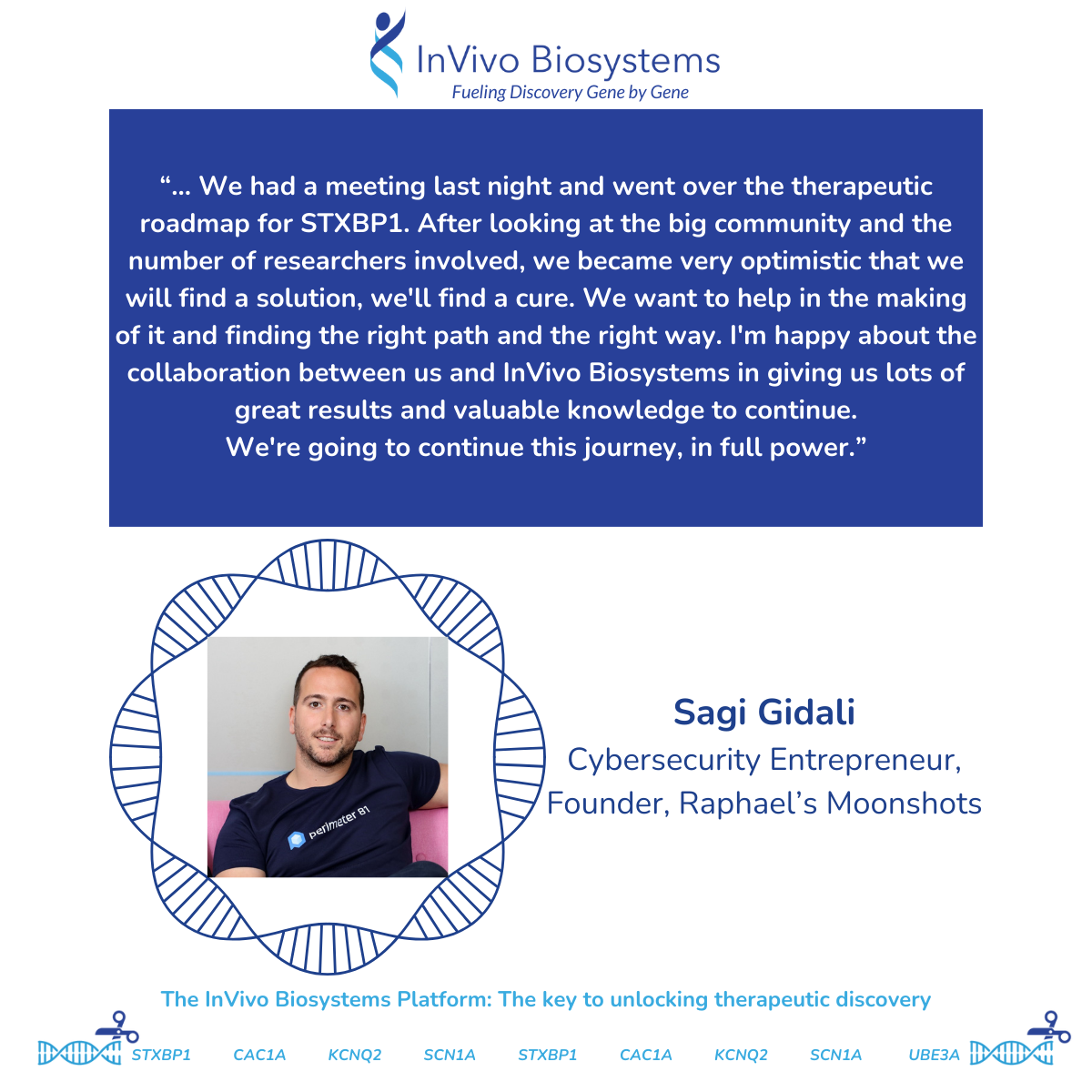
InVivo Biosystems
And from that moment when you thought, well, we’re going to do something about this take it to a level of having the foundation, what did that pathway look like?
Lior Dor
Well, when Ran was diagnosed, actually, I started to read, and what I would say is, the only advantage that I had is just that I had a background in biology and access to, to articles, to papers.
That’s it. I was in my master’s degree. I didn’t know anything about neuroscience. And I started reading and trying to really try to get to anyone that have anything related to STXBP1. And I started, I mean, I have like, the one night that I, all the night I tried to write researchers around the world–people, clinician, and everyone, that have anything.
And by the way, this is how I got to NemaMetrix (InVivo Biosystems). I was looking in the YouTube as well, so I found a YouTube, presentation of Chris Hopkins that was presenting a STXBP1 worm, which was shockingly the same, the same variant as my son. So I contact him and this is how it worked.
But in order to raise funds. I mean, the initial goal was not to try to ask, money from our close family and friends. I wanted to, you know to try to reach out in for grants. And, as I told you, apparently you cannot do that if you are a private person, you have to have a foundation and organization.
So this is actually what happened. And I remember I don’t remember which birthday it was, but I asked my wife for that birthday just to generate an organization so we can start raising funds. And this is what happened. And we, one thing led to another. And in 2017, we generated the organization.
But this is what happens and this is how it was. So I think that other families I really, as I told you before, it’s really families are different. I mean, each one gets it differently, receive this this news differently, this situation differently.
InVivo Biosystems
Shifting our focus to a broader picture, how are you approaching the challenge of finding therapeutic solutions for STXBP1 disorder? What strategies have shown promise and how has your approach evolved over the course of your journey?
Sagi Gidali
Maybe I can start off. Like our panel, how we see the, the high level of the macro picture of finding a cure. So, I think that one of the big things that we did at the beginning, after we met Lior, is basically building the infrastructure. For every treatment that you want, if it’s like small molecules, and CRISPRs, any different things or treatment that you want to test, you need a disease model.
So two weeks after we started to generate our lines of iPSCs of me and Raphael. Lior also has his, lines of, iPSCs and eventually we are now sorting them into cortical cells and we’re going to scan different potential drugs that we found that we already validated, with you guys.
So we started with that. We talked about the high throughput, how to scan libraries of different drugs. So we wanted a model that will allow us to do that. So we thought at the beginning about using yeast, but then Lior told me about your company and then we approached you.
So we already had a contact. And recently, three months ago, we started to develop a mice model, with our mutation. It’s a missense mutation and Lior also has their mice developed and characterized So that was the infrastructure. And then we said, Raphael is very young. It’s time-sensitive, and we want to build like the three phases plan.
So we start with the short term, how we’re going to do drug repurposing and look for small molecules that will have effective treatment. We use for that, like another company, that we did in silico scanning. And Lior connected also me and Ella to this company. And eventually we got like a list of 50 compounds that have a positive effect.
Theoretically, that was the hypothesis. 16 of them are crossing the blood brain barrier and three of them were over-the-counter supplements. So this was like a decision point for us, and we decided to, to start using the supplement before trying the drugs on different models.
So basically we started an n of one clinical trial for Raphael in six to seven months. And in parallel, we started to validate the different compounds and eventually we saw like three hits in our scan. And one of them was the compound that Rafael is taking. And we do see a very impactful, very positive impact on Rafael development while he’s taking it, even though it’s very hard to associate or attribute the compounds and the effect of it on Rafael.
We’re starting to test or continue to test and validate like on different models and we get like a very positive feedback from the caregivers and the PT, OT, and the speech therapist and all the environment, which we didn’t tell them that we’re doing that trial. So this is the first approach, which is a short for the short term.
And very fast midterm, we thought about like the existing technology. So we know that, about gene therapies and ASOs, and we already started to develop an ASO in Sheba Hospital, which is one of the biggest hospitals in the Middle East. And we’re also scanning and scouting for more advanced technologies.
So we’re looking for the technologies of the future, let’s say five to eight years from now, and this is where we’re going to get to a full cure. We’re working together with Lior and the US SXBP1 Foundation. And basically, it’s all about sharing knowledge and collaboration.
InVivo Biosystems
Transitioning to tangible outcomes. What are you doing with the results generated from your collaborative efforts? How have you utilized that data and, and what significance does it have for you personally? How is it informing the treatment decisions for your child?
Sagi Gidali
So the idea is to not just doing the research for the sake of the research is basically helping the kids and creating like a platform to validate, to scan for new treatments or new compounds, doing the validation and eventually giving the treatments to the kids.
So I think that we can, we did like the first, live experiment on Raphael, and I think that we can replicate it for many other kids and help them.
Lior Dor
At the beginning, the first thing I thought about is the first thing that I read of, which was gene therapy, like the common gene therapy, which is to get the gene, put it inside the vector and enter it to the body.
And this is what I wanted to achieve at first, but this is, it was very challenging. I mean, there is a mouse model that we need to create and also the knowledge that was gained about the disorder and about the all the biology, the pathway, and about basicallymany things kind of evolved, through the years.
And if at the beginning there was only thought about it’s a haploinsufficiency, a disorder where there is a one allele that is a one allele that create a function in protein, the other one that the protein degradates. Now there are some different thoughts about it, and it’s also evolving.
And so for any of these scenarios, you have to have a different approach. For example, the gene therapy. Now there are several gene therapy projects already ongoing. So I don’t think we need to do the same thing over again. So we’re trying to think about, and we do other stuff.
Like Sagi mentioned, several years ago when I met you, Shula, we wanted, we had a project with the worms and it didn’t succeed because the there was something in the infrastructure that didn’t work. And since you, since then you also evolve and you have now a new essay that is working for our world.
So everything is kind of a trial and error and, and it can be frustrating sometimes, but this is how it is. This is biology. So, hopefully now, now there are much more projects that are ongoing. We have the worms and we’re working on some RNA editing project as well in the past several years.
And hopefully we will get more and more advancement in our project until reaching the end goal.
InVivo Biosystems
Well, over the course of this journey, can you share what lessons you have learned about approaching rare diseases? What insights or experiences have shaped your perspective?
Lior Dor
So like I told you, I had a chance to talk to different families with different disorders since we, we got our diagnosis and I started looking for information, I kind of managed to gather knowledge that can help others as well, I think. So I know about the special databases and websites. And so every now and then there is another family and I try to help them and to try to look for information that can advance their goal.
So I met different people and the conclusion is, as I told you, there’s a great variability. I mean, families are different, as I told you, and, and each one gets, and if, if you, if you go a little bit wider to the rare diseases, so every disorder is different. So within the disorder, there’s much variability and every disorder is different.
So you cannot, how to say, include all of them in one package. It’s different families do different stuff, receive this news differently and yeah, this is how I think we need to interact with them, knowing that we don’t know what they’re going through.
And every family has their own issue, their own stack of issues. I call it, it’s different stack of issues and this is what they know. And sometimes you cannot compare both. Yeah, I mean, all the these things, because it’s kind of it’s really different between everyone.
Sagi Gidali
I think we had a meeting last night and we went over the therapeutic roadmap for STXBP1, and we saw the big community and the amount of researchers and we’re very optimistic that we will find a solution, we’ll find a cure.
We want to help in the making of it and finding the right path and the right way. And I’m happy about the collaboration between us and In Vivo Biosystems in giving us lots of great results and valuable knowledge to continue. And we’re, we’re going to, to continue that journey, in full power.
InVivo Biosystems
Lior and Sagi, thank you profoundly for joining us today and generously sharing your, your deeply personal story with us. We extend our best wishes for success in all of your pursuits, and we are truly grateful for the impactful endeavors that you are undertaking on behalf of, uh, of patients and their families. Thank you.
Learn More About Us and Our Work:
